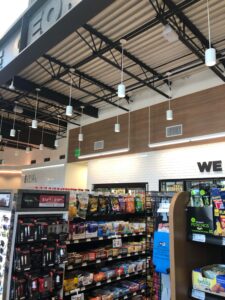 Convenience store retailers are increasingly considering energy-efficient options when looking to renovate existing sites or build new locations, and installing LEDs is a popular method to accomplish this. In fact, many chains are looking to move even farther forward with their alternative energy goals.
Convenience store retailers are increasingly considering energy-efficient options when looking to renovate existing sites or build new locations, and installing LEDs is a popular method to accomplish this. In fact, many chains are looking to move even farther forward with their alternative energy goals.
TXB, which operates 48-plus locations in Texas and Oklahoma, uses LED lighting in every store.
“Early in the design process for our new TXB-branded locations, like the one in Georgetown, Texas, I came across these round, suspended light fixtures in Europe and loved the statement they made,” said Kevin Smartt, CEO of TXB.
Smartt brought that concept to the design team, which resulted in a square version of the light fixtures from Solera Corp. The shape aligns with the square elements in TXB’s branding.
“These are now placed in the sales floor area as this location has high ceilings, and it highlights our offerings nicely,” continued Smartt.
When it comes to the design of the physical site, details such as lighting affect customer foot traffic, according to PDI and GasBuddy’s “Tracking Convenience Report: From the Pump to the C-Store,” which analyzed fuel and convenience retail trends.
The report indicates that foot traffic increased by 5.3% at sites with an above average rating in outdoor lighting. A below average rating caused an 8.5% decrease in foot traffic. One likely reason is more well-lit spaces give customers a greater sense of safety, especially if they are traveling in an unknown area.
At TXB, in addition to LED lighting, the chain capitalizes on natural day lighting.
“While it’s not a light fixture, it’s a great light source and makes the store more energy efficient overall,” said Smartt.
Both LEDs and natural lighting lower energy costs and greenhouse gas emissions. They use less energy, and lightbulbs are replaced less, which lowers product costs.
To compound the benefits of its lighting, TXB also uses its lights to encourage community engagement and connection by having the lights change colors during times of celebration.
“When designing, we wanted to make sure our lights were customizable for each location. This allows for the store to represent school colors for game days or change colors for specific holidays and local events. This is another way TXB connects with the local community we serve,” said Smartt.
Pete’s Convenient Stores, operating 50 stores in Missouri, Kansas and Oklahoma, uses LED lighting in 90% of its stores in the ceiling, fuel canopy, perimeter lot and elsewhere.
Eventually, all lighting will be converted to LEDs, said Brenda Elsworth, chief operating officer of Pete’s Convenient Stores.
“LED fixtures run cooler and usually come with a five- to 10-year warranty,” she explained.
It offers a cleaner, crisper light for more pleasant surroundings, Elsworth continued. There is also much less maintenance required with LEDs.
 Energy-Efficient Options
Energy-Efficient Options
In addition to LEDs, there are multiple other methods for convenience stores to bring about greater energy efficiency.
Stewart’s Shops uses hydropower through a partnership with Gravity Renewables. The c-store chain purchases hydroelectricity that the Comtu Falls project in Springfield, Vt., generates. This is used to offset the power used to run all nine Vermont shops.
Stewart’s Shops operates 357 locations in upstate New York and southern Vermont.
Stewart’s works well with Gravity Renewables and Comtu Falls because its landscape pattern is similar to hydropower facilities. A large number of sites are located in original hydropower towns.
In addition to hydropower, Stewart’s also uses solar power. Thousands of solar panels are used to offset electricity used not only at its manufacturing plant, but also at more than 50 shops. This is especially beneficial in the summer, as Stewart’s is known primarily for its ice cream, and the panels can help offset the electricity used to power the stores and keep them cool.




